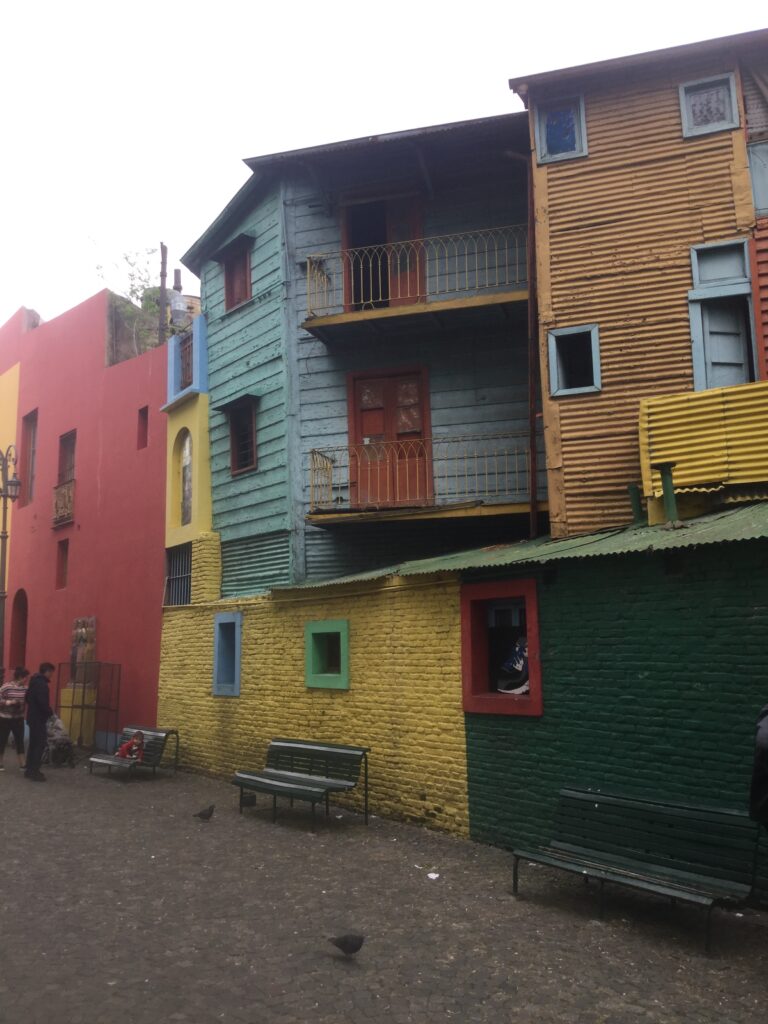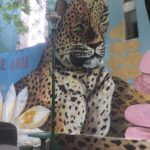My return to Buenos Aires was marked as being a bit of an Admin Day. I got up, had breakfast with a large calabaza of maté and got to work. It was payday for one of my clients. Unfortunately, I accessed a payment app on my stolen phone, so this round needed to be done through Paypal which took a hefty fee. I then called a friend of mine in New Orleans that had dreamed of traveling through South America. We talked a little bit and he informed me of his plans to run for office in the New Orleans chapter of the Screen Actors Guild, of which I was a member. I closed out the day back at Don Ernesto. I made my rounds and then headed back home to finish my work.

The next day, I headed for a walking tour in La Boca, the famous neighborhood and the birthplace of the tango. In the time it took me to get there, with inflation being what it was in the country, the price for the tour had risen by 200 pesos. When I got to the entrance of the neighborhood, there were festooned tango dancers with fedoras rather forcefully demanding tourists pay them to take photos.

There were a lot of interesting things I learned on the tour: it was the Genovese Italians that settled La Boca, Syria is the biggest importer of maté, the Brits built the ports, railroads, and subway. But, one of the most important things I learned was about soccer.

This neighborhood was very poor and working class. They took great pride in their football club the Boca Juniors. So much so, that the president of the club became a congressman, was voted to be mayor, and then eventually President Argentina. But this man’s popularity paled in comparison to their most famous player, Diego Maradona. While Maradona started his career for another team, he gained notoriety playing for the Boca Juniors. He then represented Argentina at the World Cup in 1986 and in the quarter-final match scored two goals against England, each would be remembered for different reasons. The first was he was able to dribble the ball 60m past five English guards to score, which some called the goal of the century. However, the other was much more scandalous. In an era before instant reply, when he was at the net, he jumped and tried to head the ball in the goal past the goalkeeper. However, from all the camera angles, it looked like it was his hand that guided the ball in. Since the referees did not have a clear vantage point, the point stayed. And with the other, Argentina was able to square off against West Germany eventually winning the World Cup. When asked about the goal, Maradona stated it was made with, “a little with the head of Maradona, and a little with the hand of God.” This entered the Argentine lexicon as the mano de Dios. And it was then when the tour guide showed us a photo of the mano de Dios, I realized it was the exact same photo hanging two stories in my hostel. While Maradona was a playboy, always hobnobbing around with girls, champagne, and cocaine, that did not stop his popularity. It enhanced it. While people flippantly say that football is a religion in other countries, here it is an actuality. Maradona has his own religion, the Iglesia Maradona (Church of Maradona.)

As I was leaving the tour, I noticed a very large mural of a native chieftain with the name of the artist spelled Sudakkka. I knew this word. When I was living in Spain in the early 2000’s, there was a very nice woman from Colombia that cleaned the residence hall where I was living. Spanish university students were not expected to clean up after themselves and this woman would let herself into all our rooms when we were gone and make our beds and clean up. Apparently, for some reason, one of the more nasty girls in the dorm did not like the job she did and said she was una sudaca simple. I was not familiar with the term. Since the Colombian lady and I got along, a few days later, I asked her what it meant. She understood I was a student and intended no offense. She said that the word sudaca was a slur by the Spanish for people from South America, a kind of portmanteau of Sud for South and Aca for America. With the wave of violence that occurred in those countries during the 60s and 70s, there was a massive influx of people from there to the safer shores of Spain. This provided a lot of consternation for the native Spanish. After many years, while the term could still be used in a negative context, it can also be used as a prideful recognition.

The tour was pretty good. I came back to the hostel to get ready for the rest of the day. Brenda was not feeling well, so I gave her some Dayquil and Nightquil that I always carry with me when I travel. I also made good on a deal I had with Oren. Because I was the only person drinking Fernet this whole time, he said that when I finished the bottle, all I would have to do is buy a new one to replace it and he would not charge me for all the drinks I was putting on my tab. So, I went to the local convenience store, bought a bottle, and presented it to Oren.
I got changed, then headed over to El Almacen for dinner of pork porchetta or as they call it bandiola. It was delicious. I paired it with a nice wine and just enjoyed the civilized nature of everything. I then headed over to the Temple Bar for one last language exchange.

I ended up falling in with two 20-year-old Spanish girls that wanted to practice their English. So we got a booth and started chatting. Carmela was a tattooed kickboxer with dreads and was studying Greek and Latin in University. Her friend was Mikela, a cute little thing that fancied herself an actress. We had a good long conversation about Argentina, America, Hollywood, politics, and the like. I liked them, so I offered to get us all the next round. I did this because I remember what it was like to be a college student. When I got back with the beers, I noticed that a gentleman took my seat. I stood there looking imposing, and he got the hint and moved from my seat. When I sat down, I offered them to grab some chairs to join our conversation. The conversation was not mine to control, but the bench was. The guys ended up leaving after a few minutes, but I talked with the girls until they left about an hour later. I then decided to call it a night myself.

Even though I did not sleep well, I rallied the next morning for another walking tour. This one was in the Palermo neighborhood, one of the more posh ones, and focused on street art. I learned many things. First is that street art is much more accepted as a form of expression in Buenos Aires than in other places. The second was more philosophical. My guide said that advertising and political campaigns are choreographed messages that come from some centralized authority; from the top down. Street art is more grassroots, individualist, and from the bottom up.
After the tour, I got back to the hostel and took stock if I had everything I needed to do to commemorate my time in Buenos Aires. After that, Oren asked if he could take me to dinner. I said sure. We went to a Peruvian restaurant called Rawa where I was introduced to the custom of Peruvian cuisine having two carbs, usually potatoes and rice to go with the entree. It was incredibly good. After, I headed up and went to bed.

For my last day in BA, I got up around 9, did some work, and headed out to say goodbye to the city. It was raining, so I took that as that the city was going to miss me. I walked back to the Ateneo bookstore for one last look. Back outside, the tile sidewalks were slick with water. As I was walking on an angled embankment for wheelchairs, I slipped and fell into traffic. Thankfully there were no cars. As fast as I could, I got back on my feet and raised my hands in the air like I just finished an Olympic routine. I asked the gentleman crossing the street that no doubt saw the whole thing if I scored a 10. He laughed and just kept going.

I headed back down to Puerto Madero to finally have what everyone in the whole country was talking about, a Fernet with Cola. It was utterly and completely awful. After, I headed back to Berlina Bunker for a final craft beer.

Afterward, I stopped to get a selfie with a rather famous local. If you go to Argentina, you will no doubt see the face of Mafalda. Mafalda was a very popular comic strip in Argentina in the 1960s and 70s. According to the creator, it was supposed to be a mix of Peanuts and Blondie. The main character was an incredibly precocious six-year-old that would ponder questions regarding the world and how things were, often at the detriment of her parents. It was a real piece of the Argentine zeitgeist, and one saw her face all over the country.

I then went back to the hostel for a little rest and got ready for dinner. Oren was taking me out along with Brenda for my final meal at Don Ernesto. It was delicious. There was good conversation, excellent wine, and great food. While we took a cab there, we walked back to the hostel. As we were walking, I mentioned home was this way. Oren took great delight in the fact I called it home. I told him that that is what it felt like.

We arrived at the hostel where Oren and I hugged as he would not be awake by the time I was leaving. I then said goodbye to Brenda when she told me something I would never forget. She said that she never liked Americans. She said that she thought they were rich and spoiled assholes that thought they owned the world. She said that I changed her opinion. We hugged as she fought back tears. It was an incredibly lovely sentiment. Personality, not nationality. With that, I headed up to my room for my last night in Buenos Aires.













No comment yet, add your voice below!